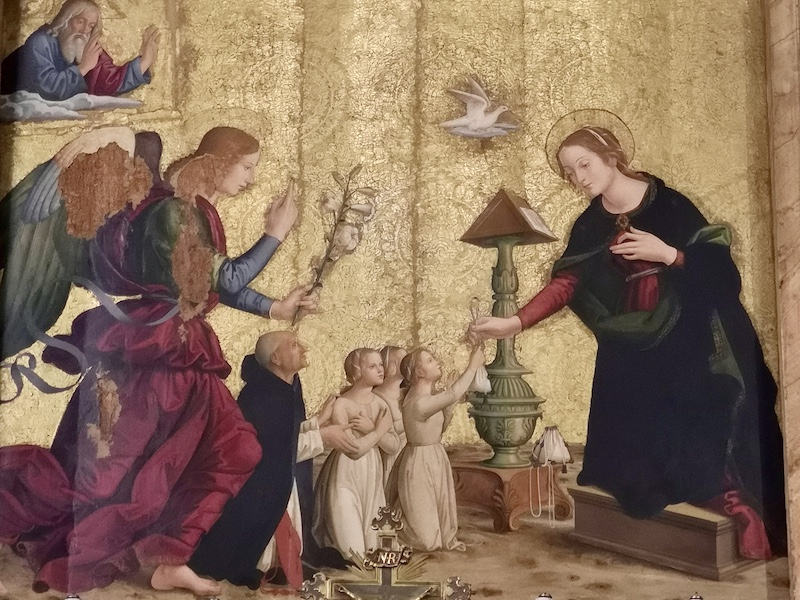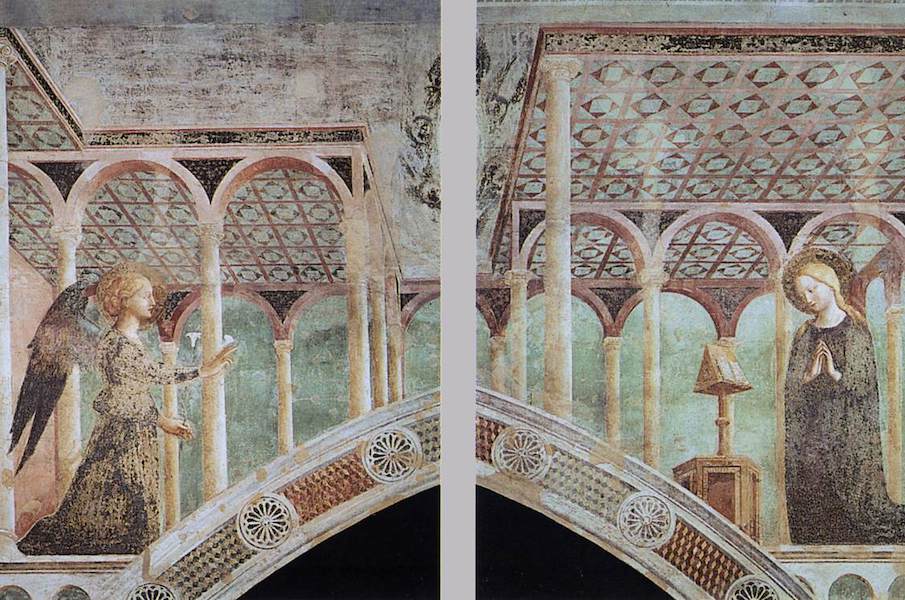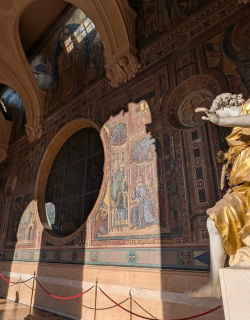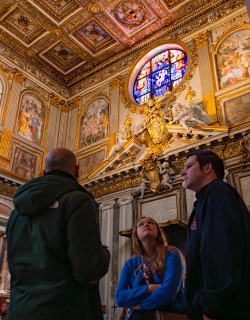“Hail, Mary, full of grace! The Lord is with you.”
Today is March 25, the Feast of the Annunciation - an occasion that marks one of the most pivotal moments in the Christian story. According to Christian tradition, it was on this day that the Angel Gabriel appeared to Mary with a message that would change history: she was to bear the Son of God.
For centuries this miraculous encounter has proved to be fertile ground for some of history’s finest artists, who continually sought new ways to convey a sacred mystery where the divine and the human collide. The encounter is almost always the same: a celestial messenger, a humble yet radiant Virgin, a beam of divine light. And yet, no two Annunciations are quite alike.
To mark the Annunciation, today in our blog we’re profiling some of our favourite artistic renderings of the subject that you can see in Rome. From simple early-Christian renderings to glittering medieval mosaics and superb Renaissance panels, join us as we head off in search of 7 masterpieces that bring the biblical tale to life in the Eternal City.
1. Pietro Cavallini, c. 1298
Santa Maria in Trastevere
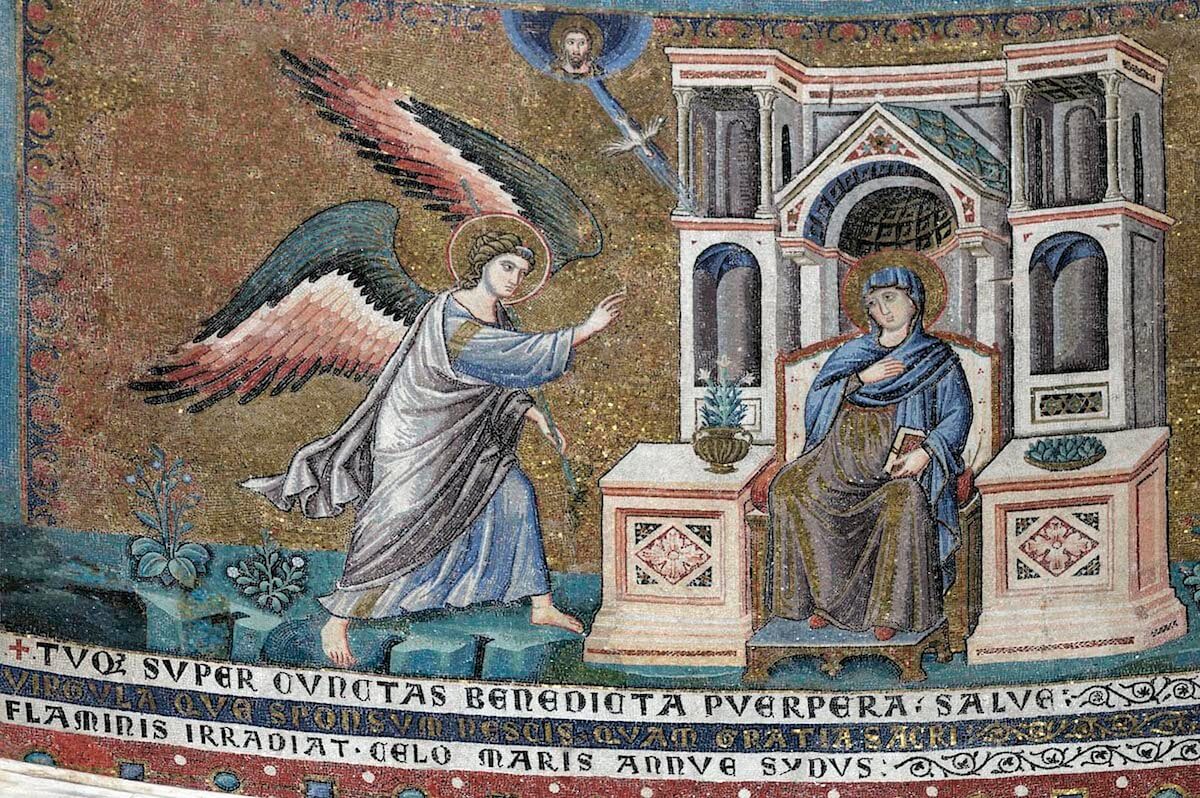
Pietro Cavallini’s masterful mosaic cycle depicting the Life of the Virgin at Santa Maria in Trastevere is a defining moment in late medieval Roman art, a bridge between Byzantine tradition and the emerging naturalism of the Renaissance. Commissioned as part of a grand decorative campaign in advance of the Holy Year of 1300, the mosaics were intended to reinforce Marian devotion among the vast numbers of pilgrims descending on Rome.
In the Annunciation, Gabriel enters from the left, mid-stride, his robes billowing as he delivers his divine message. His multicolored wings gleam in the tesserae’s flickering light. The Virgin sits enthroned within an elaborate architectural setting, her posture expressing both surprise and solemn acceptance: “who, me?”
Cavallini’s Annunciation is remarkable for its innovative creation of spatial depth and naturalistic drapery; the figures possess a sculptural solidity that anticipates the advances of Giotto, signaling the dawn of a new artistic era. Simply put, one of the great treasures of medieval Rome. Get the full story with our online guide here: Renaissance Stirrings in Medieval Rome.
2. Filippino Lippi, 1492
Carafa Chapel, Santa Maria Sopra Minerva
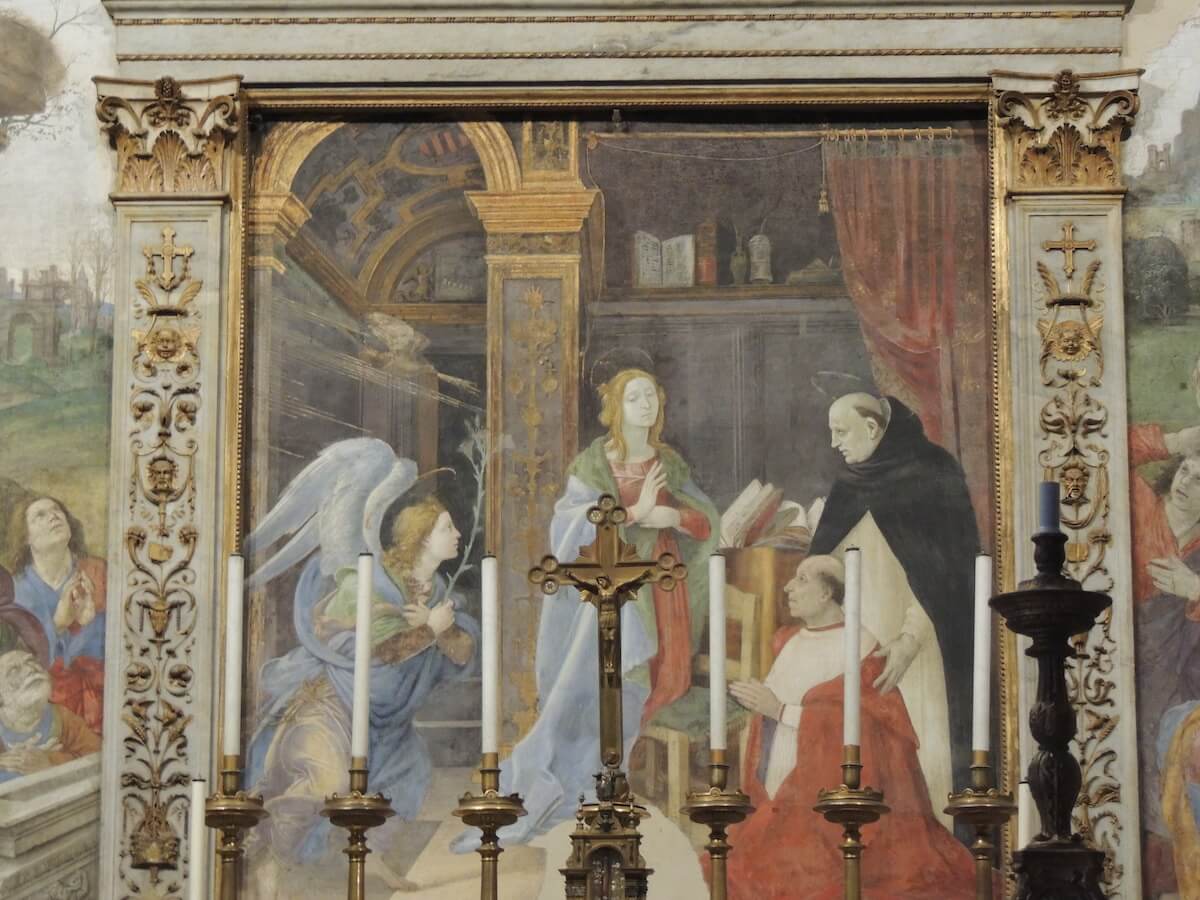
Filippino Lippi’s Annunciation in the Carafa Chapel is a dazzling display of Renaissance illusionism and personal patronage. Commissioned by Cardinal Oliviero Carafa, the fresco occupies the main altar wall, designed to appear as an independent panel painting within an elaborate trompe-l'œil stucco frame. The scene was unveiled with great fanfare on the Feast of the Annunciation in 1493, attended by none other than the Borgia Pope Alexander VI himself.
Lippi places the sacred encounter within the luxurious setting of a Renaissance scholar’s study - Carafa’s own - where a cleverly painted glass carafe on a bookshelf offers a subtle pun on the Cardinal’s name. The kneeling angel Gabriel extends a lily to a startlingly beautiful Virgin, who stands before a lectern. Above them, the Holy Spirit rushes in on a gust of divine wind, its presence accentuated by Lippi’s ethereal light effects.
Strikingly, Carafa himself is somewhat presumptuously (and anachronistically) present at the event, introduced into the scene by Saint Thomas Aquinas - his fellow Dominican and intellectual lodestone. What better way to underscore Carafa’s prominent role as one of Rome’s most powerful figures?
For a detailed account of the Carafa chapel and Lippi's superb frescoes, see our article here: Filippino Lippi in Santa Maria Sopra Minerva.
3. Antoniazzo Romano, c. 1485–90
Santa Maria Sopra Minerva
Antoniazzo Romano’s Annunciation in Santa Maria Sopra Minerva is a beautiful, glittering display of Marian devotion, testament to Antoniazzo’s role as the leading painter of the Roman quattrocento. The Virgin Mary, resplendent in ultramarine robes, kneels before an elaborately sculpted lectern as Gabriel, clad in luminous vestments, extends a delicate lily. The Holy Spirit, rendered as a radiant dove, descends on a cloud through a sea of gold.
A striking feature of Antoniazzo’s Annunciation is its devotion to material richness; the shimmering gold leaf, minutely patterned textiles, and meticulous rendering of surfaces create an atmosphere of heavenly majesty. Yet within this resplendence, the figures remain deeply human, their expressions suffused with gentle realism.
Intriguingly, Mary is shown in the act of handing a small pouch to three young women. This is a subtle reference to the charitable work of the Archconfraternity of the Annunziata, the organization that commissioned the altarpiece. The confraternity was devoted to providing dowries for young women of good character but limited means who were otherwise at risk of falling into prostitution.
Each year on the Feast of the Annunciation, the chosen recipients would process into Santa Maria Sopra Minerva, where they would receive their dowries in silk pouches. At the heart of these charitable efforts stood the Dominican friar Juan de Torquemada, whose presence in the painting provides the key to its interpretation. The inclusion of these young women offers a fascinating window into the complex social world of early modern Rome.
4. Masolino da Panicale, c. 1428–31
Castiglione Chapel, San Clemente
The Castiglione Chapel at San Clemente offers up one of the great monuments of the early Renaissance in Rome. Fresh from their career-making success in the Brancacci Chapel in Florence, dynamic double-act Masaccio and Masolino repeated the trick in the Eternal City.
Commissioned by Cardinal Branda Castiglione, a distinguished diplomat, the chapel’s decoration reflects a humanist commitment to knowledge. While the larger program focuses on the lives of the learned Saint Catherine of Alexandria and Saint Ambrose, the Annunciation above the chapel’s entrance serves as a prelude to these narratives of divine wisdom.
Gabriel, approaches Mary gently from across the space of a lovely arcade divided by slender columns, his gestures measured and harmonious. Divided by the top of the chapel’s arch, Mary is pictured at the other end of the colonnade, hands clasped in prayer. The scene is suffused with a tender, dreamlike atmosphere, enhanced by Masolino’s use of soft pastel hues and a subtly graded light that lends the figures an ethereal glow - hallmarks of Masolino’s lyrical style.
5. Filippo Lippi, c. 1440-45
Palazzo Barberini
Filippo Lippi’s Palazzo Barberini Annunciation offers up a truly dazzling vision of an opulent Renaissance interior. Marble surfaces gleam, a canopy bed beckons us towards a bedroom at the back left, while a lush garden opens out beyond an open doorway. Gabriel, garlanded with flowers and wings flecked with gold, proffers a lily to the serene Mary, framed by the arch of a colonnade.
Two kneeling donors lean on a wooden balustrade, seamlessly integrated into the composition. My favorite detail, though, are the two young women caught in the act of disappearing up a staircase to the right - just the kind of naturalistic detail drawn from life that typified Lippi’s ability to integrate the quotidian into sacred narrative.
A Carmelite friar turned court painter, Lippi led a tumultuous life that included a love affair with a nun, which led to the birth of Filippino Lippi (whom we have already met). But Lippi’s eccentricities only add to his legend as one of the most gifted and unconventional artists of the Renaissance.
6. Federico Barocci, 1582–1584
Vatican Pinacoteca
Federico Barocci was among the most celebrated painters of the late 16th century, renowned for his luminous color palette and profound spiritual intensity. Deeply devout, Barocci viewed his art as an instrument of faith, and his stirring paintings were perfectly attuned to the Counter-Reformation’s call for emotionally engaging, theologically rich religious art - works that could draw the viewer into direct contemplation of divine mysteries.
The Annunciation housed today in the Vatican Pinacoteca perfectly exemplifies this vision. The intimate scene unfolds within the Virgin’s quiet chamber; a book slips from Mary’s fingers as she is momentarily startled by Gabriel’s arrival, who proffers the usual lily - traditional symbol of the Virgin’s purity. Draped in a brilliant blue robe, her gentle expression is matched by the angel’s - all here is sweetness and light. Through the window we glimpse the twin towers of the Ducal Palace of Urbino - a nod to the paintin’s patron, Francesco Maria II della Rovere, duke of Urbino.
See Barocci's superb Annunciation alongside other Renaissance masterpieces in the Vatican Pinacoteca with our in-depth tour of the Vatican museums.
7. Anonymous, 2nd-3rd century AD
Catacombs of Priscilla
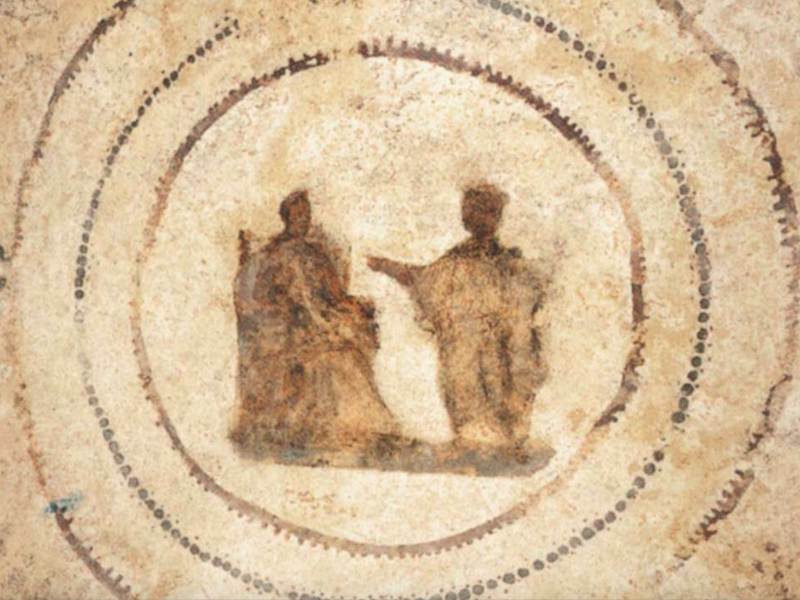
The last entry on our list is also the oldest Annunciation - anywhere! Beneath the modern streets of Rome lies a hidden world, a vast underground network where the earliest Christian communities buried their dead, gathered in worship, and left behind some of the first visual expressions of their faith. The Catacombs of Priscilla, often called the "Queen of the Catacombs," are among the most significant of these subterranean necropolises, preserving a wealth of frescoes that illuminate the devotional practices of the city’s persecuted faithful.
It’s here, carved into the soft tufa rock that we find what many believe to be the oldest known depiction of the Annunciation, dating to the late 2nd or early 3rd century. The image is striking in its austerity: Mary sits in profile on a high-backed chair, her head uncovered. Opposite her, a robed, wingless figure - likely Gabriel - raises a hand in greeting. No gilded splendor, no celestial light, only the essential elements of the encounter. Rooted in the visual language of Roman funerary art, this early Annunciation is simple and direct: the vision of a faith still emerging from the shadows.
We hope you enjoyed this journey through some of the most beautiful paintings of the Annunciation in Rome. Spanning centuries of devotion and artistic brilliance, these masterpieces are even more extraordinary when seen in person. If you’d like to experience them up close, consider joining an expert-led tour of Rome to uncover the history, symbolism, and hidden details behind each work. There’s always more to discover in the Eternal City!
MORE GREAT CONTENT FROM THE BLOG:
- How to Visit the Vatican in 2025
- What to See in the Vatican Museums
- The Best Vatican Tours to Take in 2025
- A Pilgrim and Tourists Guide to Jubilee 2025
- 7 Things You Need to See in St. Peter's Basilica
- Hidden Masterpieces of the Vatican Museums

